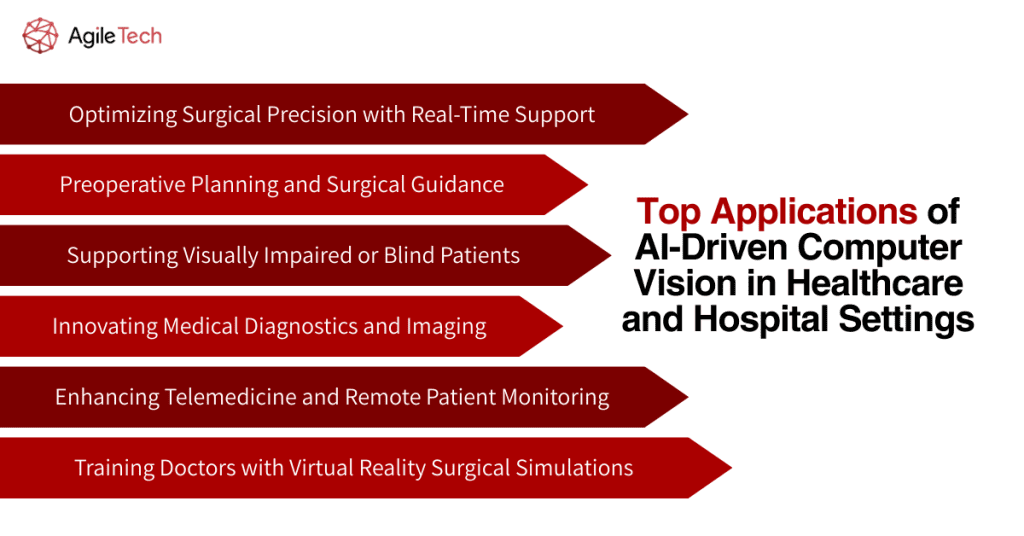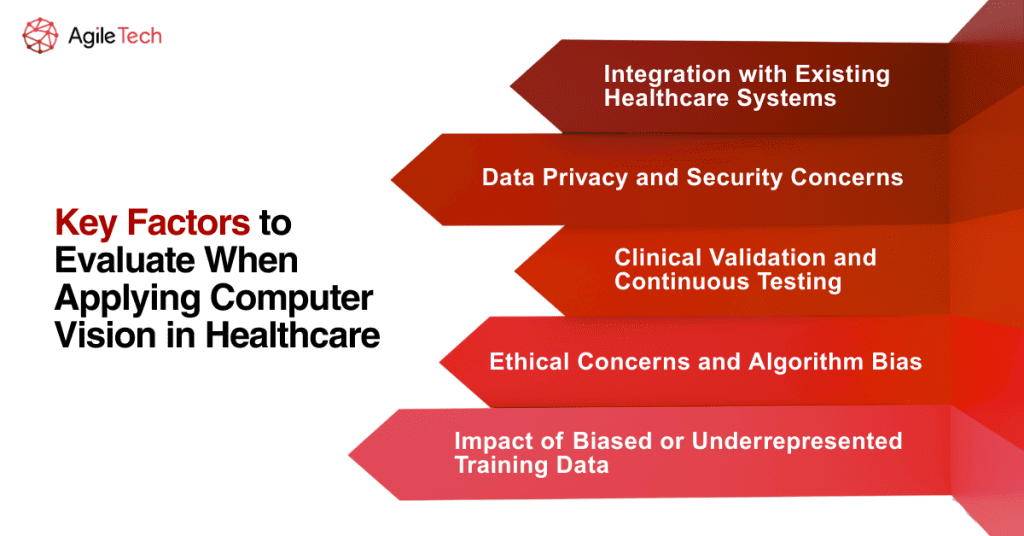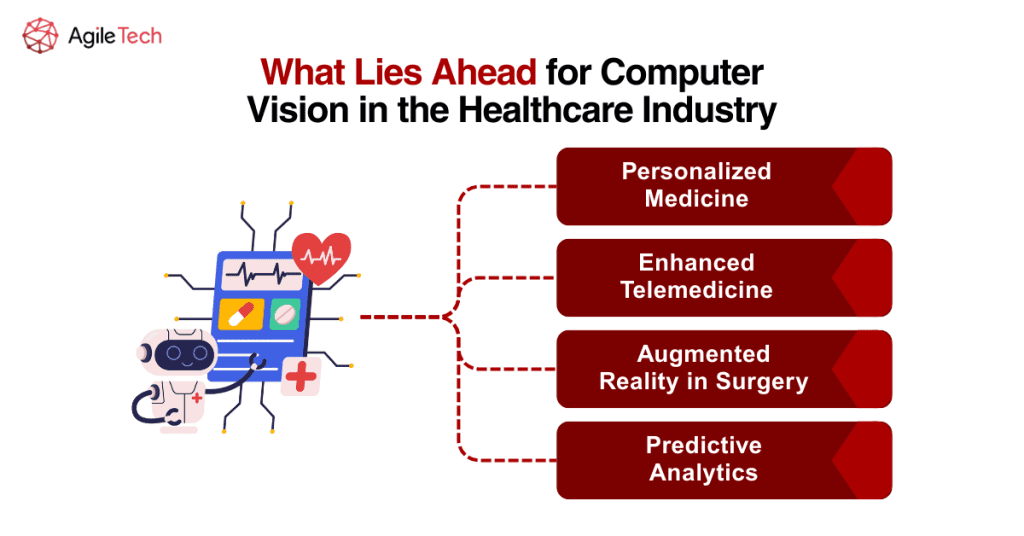Harnessing Computer Vision in Healthcare: Transforming Patient Care and Clinical Workflows
Computer vision, a subset of artificial intelligence (AI), is revolutionizing the healthcare industry by enabling machines to interpret and process visual data akin to human vision. This technology is enhancing diagnostic accuracy, streamlining hospital operations, and improving patient outcomes. As the global market for computer vision in healthcare is projected to surpass $53 billion by 2034 , it’s imperative to understand its applications, considerations, and future prospects.

- 1. Understanding Computer Vision in Healthcare and Its Functionality
- 2. Top Applications of AI-Driven Computer Vision in Healthcare and Hospital Settings
- 3. Key Factors to Evaluate When Applying Computer Vision in Healthcare
- 4. What Lies Ahead for Computer Vision in the Healthcare Industry
- 5. AgileTech’s Approach to Applying Computer Vision in Healthcare
- 6. FAQs
1. Understanding Computer Vision in Healthcare and Its Functionality
To fully understand the role of computer vision in healthcare, it’s crucial to first grasp the fundamentals of computer vision technology. At its core, computer vision is a branch of artificial intelligence (AI) that enables machines to interpret and understand visual information from the world around them. This technology allows computers to recognize objects, detect patterns, segment images, and even analyze motion. It provides machines the ability to extract valuable data from images, much like the human eye and brain would.
In healthcare, computer vision is applied to analyze medical images, such as X-rays, MRIs, CT scans, and dermatological images, for the purpose of diagnosis and treatment. One of its primary strengths is its capacity to rapidly process and interpret large volumes of complex image data. Through the use of machine learning algorithms, computer vision systems are trained on vast amounts of visual data, enabling them to identify subtle signs of diseases or conditions that might be difficult for the human eye to detect.
A significant advantage of computer vision in healthcare is its ability to continuously improve through deep learning. As AI models are exposed to more medical images over time, they become increasingly accurate at recognizing patterns and diagnosing conditions. This continuous learning process reduces errors and enhances diagnostic performance, which is crucial in healthcare settings where accuracy is paramount.
In addition, computer vision seamlessly integrates with existing healthcare systems, such as Hospital Information Systems (HIS) and Electronic Medical Records (EMR/EHR), as well as smart medical devices. This integration allows for synchronized data flow across various platforms, enabling real-time access to patient information and ensuring more efficient workflows.
The impact of computer vision in healthcare is profound. It helps doctors make faster, more accurate decisions by reducing the time it takes to interpret medical images. By automating the analysis of images, computer vision also minimizes the potential for human error and allows for earlier disease detection. Moreover, this technology can automate various testing processes, which reduces the burden on healthcare providers and helps cut operational costs.
In addition to improving diagnostics, computer vision plays a crucial role in telemedicine, where it enables remote monitoring of patients’ health. By analyzing medical images and visual data in real-time, computer vision aids healthcare providers in delivering care to patients in remote or underserved areas, improving accessibility and patient outcomes.
However, as Dr. Christopher Longhurst, chief clinical and innovation officer at UC San Diego Health, points out, while computer vision has immense potential, it is not a cure-all. For the technology to be truly effective, it must be integrated thoughtfully into clinical workflows. When used properly, computer vision can assist healthcare providers in making more accurate and timely decisions, ultimately leading to better patient care.
2. Top Applications of AI-Driven Computer Vision in Healthcare and Hospital Settings

2.1. Innovating Medical Diagnostics and Imaging
One of the standout applications of computer vision in healthcare is the enhancement of medical diagnostics. AI-powered systems can analyze medical images such as X-rays, MRIs, and CT scans, identifying abnormalities like tumors, fractures, tissue damage, or inflammation in a fraction of the time it would take for human professionals. This technology helps doctors quickly spot potential signs of disease, improving early diagnosis.
Beyond detecting irregularities, computer vision also improves the quality of medical images. Through advanced algorithms, image sharpness is enhanced, noise is reduced, and contrast is optimized, making subtle details more visible. Some systems even reconstruct 3D images from 2D scans, providing doctors with a more detailed and accurate view of the patient’s internal anatomy. These high-quality images lead to more precise diagnoses and better treatment planning.
For example, in the detection of lung cancer, AI can analyze chest CT scans to identify small nodules that are often too difficult for the human eye to detect. Similarly, AI can assist in breast cancer diagnosis by automatically assessing mammograms and classifying risks based on BI-RADS (Breast Imaging-Reporting and Data System) categories.
2.2. Optimizing Surgical Precision with Real-Time Support
Computer vision plays a critical role in improving the accuracy and safety of surgeries. By analyzing real-time data from cameras and sensors during surgical procedures, it helps surgeons identify key structures, such as organs, blood vessels, nerves, and tumors, with greater precision. This technology is particularly valuable in complex surgeries, such as neurosurgery, organ transplants, and cancer surgeries, where even small mistakes can have serious consequences.
In neurosurgery, for example, computer vision can help locate functional brain areas, ensuring safe removal of brain tumors. In cancer surgeries, AI aids in identifying tumor boundaries, using near-infrared imaging to ensure complete tumor removal while preserving healthy tissue. Furthermore, in cardiovascular surgeries, computer vision helps monitor pulse rates and blood flow, providing real-time data for procedures like stent placements and heart valve repairs.
2.3. Enhancing Telemedicine and Remote Patient Monitoring
Computer vision also supports telemedicine by enabling remote analysis of patient images and videos, including those taken via mobile devices, wearables, or surveillance systems. For instance, AI cameras can be used to monitor changes in a patient’s skin, detecting new tumors, ulcers, or other abnormalities.
In intensive care units (ICUs), computer vision is employed to monitor patients’ movements, breathing patterns, and postures. AI can detect risks such as falls or respiratory distress and immediately alert medical staff, significantly reducing response times and improving patient safety.
2.4. Supporting Visually Impaired or Blind Patients
Beyond clinical settings, computer vision technology is also making life easier for visually impaired or blind individuals. Assistive devices powered by computer vision can help these patients navigate their environment by providing audio feedback based on real-time image processing. For instance, such devices can recognize road signs, detect obstacles, or even identify familiar faces, helping users live more independently.
Read more: Hospital Management System: Top Choices, Costs & Development Steps
2.5. Preoperative Planning and Surgical Guidance
Before surgery, computer vision aids surgeons in planning the procedure by generating 3D images from CT, MRI, or X-ray scans. These detailed models allow surgeons to better understand the injury’s location, surrounding anatomy, and any potential risks. Instead of relying on static 2D images, surgeons can rotate, zoom in, and even dissect virtual tissue layers, ensuring an optimal surgical approach.
During surgery, computer vision continues to assist by providing real-time guidance. For instance, in spine surgery, computer vision tracks vertebral positions, helping ensure accurate screw placement without damaging the spinal cord. In liver surgery, AI helps delineate liver segments and blood vessels, improving the safety and effectiveness of tumor removal.
Additionally, combining computer vision with augmented reality (AR) technology enhances the surgical experience. Surgeons can view 3D models of internal structures projected directly onto the patient’s body, allowing for more accurate and minimally invasive surgeries.
2.6. Training Doctors with Virtual Reality Surgical Simulations
Computer vision technology is also transforming medical training by enabling virtual reality (VR) surgical simulations. These simulations allow medical trainees to practice surgical techniques on realistic 3D models based on real anatomical data. The VR system provides tactile feedback, such as pressure and tissue stiffness, making the training experience more lifelike.
AI within these simulations analyzes the trainee’s actions, such as scalpel use and instrument movement, offering immediate feedback to correct errors or safety violations. This helps ensure that trainees develop the necessary skills and techniques before performing real surgeries. Moreover, VR and computer vision enable team training, allowing medical professionals to practice responding to rare emergency situations collaboratively.
3. Key Factors to Evaluate When Applying Computer Vision in Healthcare

3.1. Data Privacy and Security Concerns
Healthcare data is highly sensitive, and computer vision in healthcare relies on vast amounts of patient information, which raises significant privacy and security concerns. Data breaches or unauthorized access could lead to misuse, fraud, or identity theft, undermining patient trust and damaging the reputation of medical institutions. The risk is even higher when AI systems inadvertently capture images of individuals not directly involved in the care process, such as doctors, nurses, or visitors, without their consent.
To mitigate these risks, healthcare organizations need to implement stringent data management practices. This includes encryption, controlled access rights, and compliance with regulations like HIPAA or GDPR. Data should only be stored as long as necessary for treatment, with unnecessary data discarded to avoid prolonged misuse.
3.2. Ethical Concerns and Algorithm Bias
The training of AI systems is crucial, as biased or incomplete data can result in AI models that are discriminatory or inaccurate. If the training data lacks diversity in terms of race, age, gender, or medical conditions, it may cause the system to misdiagnose or overlook critical symptoms, particularly among minority groups or individuals with atypical health profiles.
To address these concerns, AI models should be trained with diverse, representative datasets to ensure fairness and accuracy. Transparency about the AI’s decision-making process, along with clear communication of its limitations, is vital to build trust with both medical professionals and patients.
3.3. Impact of Biased or Underrepresented Training Data
Training AI systems with biased or underrepresented data can have serious consequences. For instance, AI models might fail to recognize certain conditions in patients with darker skin tones, older individuals, or those with rare health conditions. This can lead to misdiagnoses, missed risks, or inappropriate treatment plans, potentially jeopardizing patient safety.
To prevent this, continuous updates to training datasets are necessary to ensure the AI remains accurate and relevant to all patient demographics. Additionally, the model must be rigorously validated by clinical experts before it is deployed in real-world scenarios, ensuring its diagnostic accuracy and safety.
3.4. Integration with Existing Healthcare Systems
For computer vision AI to be truly effective, it needs to integrate seamlessly with existing healthcare infrastructure, such as electronic health records (EHR) or radiology systems like PACS. Poor integration can disrupt workflows and hinder user adoption, ultimately reducing the system’s effectiveness.
Successful integration requires careful planning, ensuring that AI tools complement and enhance existing processes rather than replace or disrupt them.
3.5. Clinical Validation and Continuous Testing
Given the high stakes in healthcare, it is essential that AI systems undergo continuous clinical validation. These models must be tested regularly to ensure they perform accurately and reliably in diverse medical contexts. Clinical validation helps maintain the system’s reliability and ensures that it provides safe and effective support in medical decision-making.
4. What Lies Ahead for Computer Vision in the Healthcare Industry

The future of computer vision in healthcare holds great potential for transformative advancements that will significantly impact patient care and medical practices. Here’s a look at the key developments expected in the coming years:
4.1. Personalized Medicine: As AI-driven computer vision continues to improve, it will enable more precise, personalized treatment plans. By analyzing medical images alongside other patient data, such as genetics and lifestyle, healthcare providers will be able to tailor treatments to individual patients, leading to more effective and targeted interventions.
4.2. Enhanced Telemedicine: Computer vision integrated with telemedicine platforms will revolutionize remote healthcare by improving the accuracy of diagnostics and patient monitoring. This technology will allow healthcare professionals to detect issues in real time, even from a distance, which is especially crucial for patients in underserved or rural areas where access to specialists is limited.
Read more: Healthcare LMS Implementation: How to Create Hospital Training Software
4.3. Augmented Reality in Surgery: The integration of computer vision with augmented reality (AR) will offer surgeons a new level of precision during operations. AR can overlay 3D images of organs, tissues, and tumors directly onto the patient’s body, helping surgeons navigate complex procedures more accurately and reducing the likelihood of errors. This will ultimately improve surgical outcomes and patient safety.
4.4. Predictive Analytics: By combining computer vision with other AI technologies, predictive analytics will allow for earlier detection of diseases, even before symptoms appear. This could enable healthcare providers to implement preventive measures, leading to better long-term health outcomes and reduced healthcare costs.
Experts like Gostine and Longhurst are optimistic about these innovations. Gostine anticipates that advancements in computing power will result in a thousand-fold increase in the intelligence of AI algorithms within the next few years, making computer vision a ubiquitous tool across all healthcare sectors. He envisions it becoming a general-purpose technology that can support everything from diagnostics to patient monitoring. Longhurst, on the other hand, foresees significant benefits for specialties like ophthalmology and dermatology, where computer vision can improve diagnostic accuracy. However, he also notes that while AI will serve as a clinical decision support tool, the ultimate responsibility for patient care will still lie with doctors and healthcare providers.
5. AgileTech’s Approach to Applying Computer Vision in Healthcare
At AgileTech, we focus on developing and implementing advanced computer vision solutions that cater to the unique needs of the healthcare sector. Our approach includes:
- Customized Solutions: We create tailored computer vision applications to address specific clinical needs, from early disease diagnosis to optimizing surgical procedures with real-time image analysis.
- Collaborative Development: Our team works closely with healthcare professionals to ensure that our solutions are user-friendly and meet clinical standards, enhancing the effectiveness of the tools in practice.
- Continuous Improvement: We believe in the power of continuous learning. AgileTech regularly updates its AI models with new data, enhancing the accuracy and performance of our systems.
- Compliance and Security: Patient privacy and data security are our top priorities. All our solutions strictly adhere to industry standards, including HIPAA and GDPR, ensuring that patient data remains protected.
By integrating cutting-edge computer vision technologies, AgileTech aims to empower healthcare providers to make more accurate diagnoses, improve treatment outcomes, and enhance overall patient care. If you’re looking for a long-term, reliable partner to help you navigate the digital transformation in healthcare, AgileTech is here to support you every step of the way. Contact us for more information.